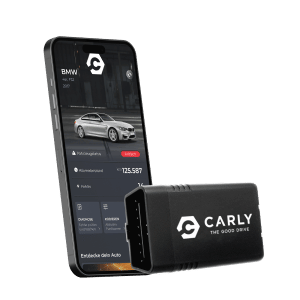Our cars are becoming increasingly filled with data! Lots of data that can be easily accessed in order to learn more about our cars and therefore have greater control over them. The door to your car’s data is the OBD ii port. However, to unlock this door you will need a small device that will become your go-to tool: the Carly OBD scanner! The OBD connector is a crucial interface for accessing these OBD functions and diagnostics in vehicles.
Whether you want to have more control over your car to save money on repairs or to customize features and make it more unique, you have made it to the right place! The OBD II connector, with its standardized 16-pin J1962 interface, ensures compatibility and accessibility for vehicle diagnostics.
GAIN MORE CONTROL OF YOUR CAR WITH THE CARLY FEATURES
Check the exact pricing of Carly for your car brand!

Fast International Shipping with DHL

14 days adaptor return policy

Excellent customer support

Lifetime warranty in the hardware
SEEN IN
Sit back, relax, and don’t worry if you are not sure what an OBD port is or how it works. Today we will help you become an OBD expert. By the end of this article, you will know the best way to gain control of your car!
Like having your own mechanic!
Introduction to OBD Systems
On-Board Diagnostics (OBD) systems are a cornerstone of modern automotive technology, providing a standardized interface for accessing a wealth of diagnostic data. These systems have revolutionized vehicle repair and maintenance by enabling both vehicle owners and repair technicians to retrieve fault codes, sensor readings, and other critical information. The journey of OBD systems began in the 1980s with the introduction of the first generation, which offered basic diagnostic capabilities. However, it was the advent of OBD II in the mid-1990s that truly transformed the landscape. OBD II brought standardized diagnostic trouble codes (DTCs) and a universal connector, making it easier to diagnose and fix vehicle issues across different makes and models. Today, OBD systems are indispensable tools in vehicle repair, helping to ensure that vehicles run efficiently and safely.
What does OBD stand for?
Let’s start with the main term that will help you understand it all! The initials “OBD” stand for “on-board diagnostics”. The OBD systems give car owners and/or mechanics access to the status of the many sub-systems a modern vehicle has.
Moreover, an OBD ii reader (also called an adapter or scanner) is a pocket-sized electronic device. It allows you access to this data, helping you see a car’s overall health status.
Additionally, an OBD ii reader also helps you detect faults earlier than your car would. It also makes it possible for you to carry out your own maintenance for your car. Thus, these features can help you save money by detecting errors early and avoiding unexpected expenses at the mechanic’s workshop!
The best part about all of this, its that you can access the data and carry out these diagnostics all by yourself in no time! Basically, you just plug the Carly OBD reader into your car, open the Carly app on your phone, and start just with a couple of taps from your phone!
For some car models, an OBD reader (technically, an OBD2 reader, as that is the latest standard) even allows you to code cool features to personalize your car.
In order to access this information and features, you only need to purchase the Carly OBD Adapter and download the Carly app.
The Carly app is the software that lets you access all the information that the OBD reader collects from your car. With the app, you can easily view your car’s information and makes changes to the software (aka coding) via your phone.
Now that you know what an OBD reader is, let’s get into detail and find out how it works!
What is the difference between OBD and OBD2?
With the previous generation of OBD adapters, the only way for connecting them to your phone was through a long cable. However, with the introduction of OBD2, you have access to more standardized error codes. Additionally, you can also connect the adapter to your phone via Bluetooth or WLAN, without the need for cables.
The evolution of OBD2 technology included the adoption of various diagnostic protocols, such as the Keyword protocol, which facilitated data retrieval from vehicle systems and marked a significant advancement in vehicle diagnostics.
At Carly, you can find the “Carly Universal Adapter” which is an OBD2 reader and can be used for almost all car brands in the world!
The OBD II Revolution

The second-generation OBD system, known as OBD II, is the star of the show today. It’s a remarkable upgrade from the first OBD computer system. OBD II made its grand entrance in the mid-1990s, bringing with it standardized diagnostic trouble codes (DTCs) and a whole new level of diagnostic capabilities.
A significant advancement with OBD II was the adoption of the Controller Area Network (CAN) protocol, which greatly enhanced vehicle data extraction and diagnostic capabilities.
Evolution of the OBD Port
Cars sold today owe a debt of gratitude to the pioneers who standardized the OBD port. Before its advent, diagnosing vehicle problems was akin to finding a needle in a haystack. Now, thanks to the OBD II system, mechanics and car enthusiasts alike can swiftly identify and address issues.
All vehicles sold in the US after 1996 and in Europe after 2001 are required to include an OBD2 port, ensuring compliance with regulatory requirements and facilitating the tracking of vehicle data and emissions.
What is an OBD port?
Now that you know what an OBD reader is, we can move to the OBD port! An OBD port is simply a space that is uniquely designed for connecting the OBD reader to it. Vehicle manufacturers played a crucial role in the development and standardization of the OBD port, ensuring compatibility across different car models.
When you take your car to the mechanics, this is the outlet where they plug in the OBD equipment. Nevertheless, their equipment usually consists of a long cable and a computer that lets them access your car’s information. Once they connect their equipment to the OBD port, they can diagnose your car and find out what parts need to be repaired, for instance.
However, with the Carly OBD and app, you no longer need to visit a mechanic or use all this complicated equipment to access your car’s data. Now, you can easily diagnose your car through your phone and a lightweight OBD adapter that you can carry in your glovebox everywhere!
Do all cars have an OBD port?
Nowadays, cars have up to 80 built-in ECUs in their system. An ECU stands for “electronic control unit”. These units are embedded in the car and they control one or more electrical systems of a vehicle.
For example, there is a specific ECU in your car that controls the fuel system. With an OBD reader, you are able to access this ECU to get data about your fuel system!
The embedded software in these ECU makes cars more sophisticated, not just in their functions but also in how much data they provide!
You can find an OBD2 port in all gas vehicles manufactured since 2001 in the European Union, and in all vehicles from 1996 onwards in the USA. Therefore, if you own a car manufactured in recent years, it will be equipped with an OBD2 port!
Is the Carly OBD compatible with my OBD port?

If your car was built after 2001, the answer is probably yes! However, if you own a BMW manufactured prior to 2001, we got you covered too! The Carly Universal Adapter is compatible with:
- Vehicles manufactured from 2001 onwards
- Mercedes built from 2005 onwards
- And every BMW from 1996* and later!
If you are not sure about your car’s manufacturing date, you can find this information in your vehicle’s registration documents. You can also check if your car brand and model are supported by the Carly OBD2 reader!
In case that you have a BMW car manufactured between 1996 and 2000, you will also need a 20-pin adapter extension to use the Carly Universal Adapter! However, don’t worry about this additional extension. You can easily find it for affordable prices on eBay or Amazon, for instance.
When looking into purchasing Carly, you might find the Carly adapter for resale on eCommerce sites. However, we highly advise you only buy adapters via our website and avoid buying Carly on eBay or other sites. This is because the Carly adapters sold by external sites or people, are resold for higher prices and do not include a product warranty or our return policy.
Carly Tip: If your requested model is not listed, choose another model of your car brand with the same build year.
Like having your own mechanic!
Where is the OBD2 port?

The OBD2 port location can vary depending on your car model. However, it is usually found within reach of the driver, underneath the steering wheel. Scroll down to see where the OBD2 port is located in your car! Additionally, you can also check the location of the OBD2 port in your car’s manual.
What can an OBD2 tell you?

OBD2 scanners are powerful tools that can provide a wealth of information about your vehicle’s health. They can read and clear diagnostic trouble codes (DTCs), monitor various vehicle systems, and even provide real-time data on engine performance.
OBD II protocols play a crucial role in decoding OBD-II signals into visual data displays, making it easier to understand and utilize the information provided by modern OBD readers.
Let’s start with the first category!
Car Diagnostics
There are 4 main data categories that the Carly OBD scanner can give you access to. Each category has many functions available for your car. However, before we dive in and explain these powerful features, it is important to note that the available functions depend on the model of your car. For example, for BMW all the functions are available, but for Mercedes, only some might be available.
Once you connect the Carly adapter to your car’s OBD2 port, you will be able to diagnose your own car from your phone! Basically, the Carly app will tell you if there are any problems or “fault codes” with an ECU, and how severe these faults are. Based on the number and severity of these fault codes (also called “error coded”), the Carly app will give your car an overall health score.
Usually, when your car needs repair or an oil change, a warning sign appears on your dashboard and you have to address these error codes immediately. However, with the Carly OBD scanner, you will be able to see errors months before they appear on your car’s dashboard. Therefore, you will aware of what part of your car need repair before it’s too late and it becomes a severe and expensive problem.
Car Maintenance
In the case that your car has error codes, the Carly app will tell you what they are related to and what they mean. However, with the maintenance feature, you can even save more money and do simple car repairs yourself!
Depending on your car model, the Carly app will give you possible options and a step-by-step guide of which maintenance fixes you can carry out on your car. For example, these can be undertaking a service reset (changing oil or brakes), registering the battery, and more!
The benefit of doing repairs yourself is that you can save a lot of time and money on basic car services. Once you have corrected all the error codes that the Carly OBD2 scanner detected, you can delete them in just one tap!
Car Coding
Moreover, the third category of possibilities is coding your car! This Carly feature lets you code particular ECUs and make your car unique. For example, you can customize the external lights, disable the automatic start-stop button, show the speedometer digitally, and much more! Again, the coding options available depend on your car model. Here you can see all the coding possibilities for your vehicle!
Used Car Check
Last but not least, is the “Used car check” feature. If you’re buying a used car, it is easy to get tricked since sellers may alter the car’s mileage or hide important information from you. However, this is easy enough to avoid with the right tool, such as Carly!
When connecting the Carly adapter to an OBD2 port, you will be able to see valuable information about the car. For example, the Carly app will tell you whether the car’s mileage has been manipulated and by how many miles. Additionally, you can also detect serious mechanical problems, see the driving history of the vehicle, and more!
The Check Engine Light Decoder
Ever had that dreaded moment when your car’s check engine light flickers to life? That’s when the OBD II port becomes your trusty sidekick. By connecting a diagnostic tool to this port, you can extract diagnostic trouble codes, revealing the specific issue that’s ailing your vehicle.
Speaking in Codes
Diagnostic trouble codes are like secret messages from your car’s internal computer. They provide vital clues about what’s going on under the hood. Armed with this information, you and your mechanic can swiftly pinpoint and fix the problem.
Connecting the Dots: OBD Port and Vehicle Speed
The OBD port is like a traffic cop for data. It’s where your car’s computer system sends and receives signals related to vehicle speed, among other critical parameters. This information is invaluable for understanding how your vehicle performs in different driving conditions.
A Diesel-Gasoline Tango
Whether your ride runs on diesel vehicles or gasoline vehicles, the OBD port is equally essential. It plays a pivotal role in diagnosing issues specific to each type of engine, ensuring that no matter your fuel preference, you’re covered.
From External Test Equipment to Plug-and-Play
In the early days, external test equipment was the go-to for diagnosing car troubles. Nowadays, it’s as easy as plugging into the OBD II port and letting your diagnostic tool do the talking. It’s like upgrading from a rotary phone to a smartphone!
Steering Wheel to OBD ii Port: The Connection
You might wonder, what does the steering wheel have to do with the OBD ii port? Well, think of it as your car’s brain and heart working together. The steering wheel guides your vehicle, while the OBD ii port provides vital feedback on its performance.
Unlocking the Potential
By understanding the relationship between the steering wheel and the OBD port, you can make informed decisions about maintenance and upgrades. It’s like having a direct line to your car’s inner voice.
Reading Diagnostic Data
Reading diagnostic data is a fundamental aspect of vehicle maintenance and repair. OBD systems provide access to a comprehensive range of diagnostic data, including fault codes, sensor readings, and other vehicle-related information. To access this data, you need a scan tool or OBD reader, which connects to the OBD II port typically located under the steering wheel column. Once connected, the scan tool communicates with the vehicle’s onboard computer to retrieve diagnostic data. This data is then displayed on the scan tool’s screen or a connected mobile device, allowing you to identify and understand any issues. By interpreting fault codes and sensor readings, you can diagnose problems early, potentially saving time and money on repairs.
OBD2 Scan Tools and Software
OBD2 scan tools and software are essential for unlocking the full potential of your vehicle’s diagnostic capabilities. There are various types of scan tools available, ranging from basic code readers to advanced diagnostic tools. Handheld scanners are portable and easy to use, while PC-based scan tools offer more detailed analysis and data logging capabilities. Mobile device-based tools, like the Carly OBD scanner, combine convenience with powerful diagnostic features. Additionally, specialized software can enhance the functionality of these tools, providing access to diagnostic libraries, troubleshooting guides, and real-time data monitoring. Whether you’re a professional mechanic or a DIY enthusiast, having the right scan tool and software can make a significant difference in maintaining your vehicle’s health.
Troubleshooting with OBD2
Troubleshooting with OBD2 systems is a systematic process that involves using diagnostic data to identify and resolve vehicle issues. By reading fault codes and sensor readings, you can quickly pinpoint the root cause of a problem. OBD2 systems also provide access to real-time data, allowing you to monitor vehicle performance and diagnose issues as they occur. Advanced troubleshooting techniques, such as data logging and sensor testing, can further aid in identifying intermittent problems that may not trigger a fault code. By leveraging the diagnostic capabilities of OBD2 systems, you can develop a targeted repair plan, ensuring that issues are addressed efficiently and effectively.
Clearing Fault Codes
Clearing fault codes is a crucial step in the vehicle repair process, but it must be done correctly to avoid further complications. Fault codes are stored in the vehicle’s onboard computer and can be retrieved using an OBD2 scan tool. Once the underlying issue has been diagnosed and repaired, the fault code can be cleared using the scan tool. It’s important to note that clearing fault codes without addressing the root cause can lead to recurring problems and potential damage to the vehicle. Therefore, always ensure that the issue is fully resolved before clearing the fault code. This practice not only helps maintain the vehicle’s health but also ensures that the onboard diagnostics system continues to function accurately.
By following these guidelines and utilizing the capabilities of OBD2 systems, you can take control of your vehicle’s maintenance and ensure it remains in optimal condition.
Can you drive with an OBD reader plugged in?
Now that you know what is an OBD port and how the Carly OBD reader works, the last question remains! Can you drive with the Carly adapter plugged to your OBD2 port? Absolutely! With the Carly Universal Adapter, you can plug it into your car and never worry again about unplugging it! Therefore, you can leave the Carly OBD ii reader plugged in your car even while you drive.
So, now that you know what an OBD port is and how to use it, answer this question for yourself:
Are you ready to have more control over your car?
Find the OBD port in your:
Wrapping Up: Your Vehicle’s Best Friend
So, there you have it! The OBD port, a small yet mighty connector, holds the key to unraveling your vehicle’s mysteries. From diagnostic trouble codes to real-time data on vehicle speed, it’s a powerhouse of information.
Next time your check engine light flickers to life, you’ll know exactly where to turn. Connect to the OBD port, decode those trouble codes, and get back on the road with confidence.
Remember, your vehicle’s OBD port is like a loyal friend, always ready to share its secrets and help you keep your ride in top shape. So, go ahead, give it a little appreciation—it deserves it! Happy driving!

